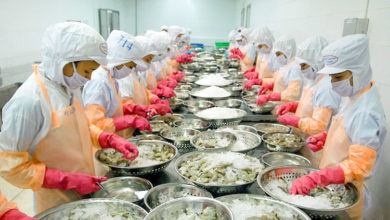Fresh and live seafood: promising opportunities in the Chinese market
In the first half of this year, seafood exports to China reached nearly $690 million, marking an 8.4% increase. Pangasius continues to be the leading export product, making up 35% with over $243 million, although this is a 7.4% decrease from last year. Frozen seafood exports have generally declined due to lower prices, whereas live seafood products show more potential.
For the first half of 2024, total seafood exports were nearly $4.4 billion, reflecting a nearly 6% y-o-y increase. Shrimp alone accounted for over 37% with $1.64 billion, followed by pangasius at 21% with over $918 million, tuna at 10.7% with $471 million, and squid and octopus at 6.6% with $289 million. Exports of other fish contributed nearly 20%, amounting to $865 million. Most major products saw an increase in export values compared to last year: shrimp and pangasius grew slightly by 6% and 5%, respectively, while crab and lobster experienced significant growth, with crab exports rising by 75% and tuna by 23%. Conversely, squid and octopus exports fell slightly by 1%, and exports of other fish types decreased by nearly 6%.
The shrimp sector is seeing promising developments, particularly in lobster, with sales skyrocketing from $46.6 million in the first half of 2023 to $126.7 million in the same period this year, a remarkable 171% increase. Notably, 98% of these sales are from live spiny lobsters (blue lobsters), with China being the main consumer.
Crab exports have seen the most substantial increase among major items, with a 75% rise to $125 million. Crab exports nearly doubled to about $93 million, while crab exports increased by 33% to over $31 million. Live crab exports alone brought in $54 million, nearly eight times the amount from the same period last year. China remains the primary market for Vietnam’s live crab products.

Fresh and live products are the highlights In the overall picture of seafood exports to China in the first half of the year, significantly boosting export revenues to this market. And as such, seafood exports to China reached nearly $690 million, up 8.4%. Pangasius continued to hold the largest share, accounting for 35% with over $243 million, though this is a 7.4% decrease compared to last year.
Lobster was the second-largest export item to China in the first half of this year, with nearly $122 million, up 174%, representing almost 18% of the total seafood export value to this market. Whiteleg shrimp exports to China declined by 10% to $117 million, while tiger shrimp exports fell nearly 30% to $38.5 million.
In addition to shrimp and pangasius, many marine fish exports to China also saw a decline in the first half of the year. However, live crab exports surged twelve-fold, reaching $49 million. Frozen seafood exports to China have decreased compared to the previous year due to falling prices, while live seafood items demonstrate better potential. Besides lobster and live crab, live clams (particularly surf clams and flower clams) and live snails also saw substantial increases, rising by 280% and 282%, respectively, compared to last year.
China’s frozen shrimp market is experiencing an oversupply situation due to a flood of Ecuadorian imports and high domestic harvests. In the first half of the year, China imported 436,000 tons of shrimp, with Ecuadorian shrimp alone accounting for 330,000 tons, or 75%.
Looking ahead, demand for salmon and lobster in China is expected to continue rising. As the leading global seafood consumer, Chinese consumers are increasingly favoring high-quality and value-added seafood products. There is a noticeable shift from buying live seafood at traditional markets to purchasing it through e-commerce channels, with shrimp being the most popular seafood product online in China.
Despite gradual improvements in inflation and inventory levels, these factors still impact demand in import markets. Vietnamese seafood exports face price competition with other supplying countries, resulting in lower average export prices for major products like shrimp and pangasius compared to 2023 and previous years.
Overall, while total seafood exports in the first half of the year are recovering, significant growth was observed only in January (+64.5%), with more modest increases in subsequent months. It is expected that in the second half of the year, Vietnamese seafood exports will return to pre-COVID-19 levels, with increased orders anticipated in the third quarter to meet year-end holiday demand in key markets.
VFM






